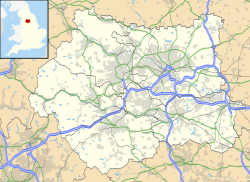| St Peter's Church | |
|---|---|
| Church of Saint Peter | |
 | |
| 53°42′55″N1°28′26″W / 53.7152°N 1.4740°W | |
| Location | Aberford Road, Stanley, Wakefield, West Yorkshire |
| Country | England |
| Denomination | Church of England |
| History | |
| Status | Parish Church |
| Architecture | |
| Heritage designation | Grade II listed building |
| Style | Gothic Revival |
| Groundbreaking | 1821 |
| Completed | 1824 |
| Construction cost | £12,000 |
| Closed | 2001 |
| Demolished | 2014 |
St Peter's Church in Stanley, Wakefield, West Yorkshire, England was a Church of England church. The church opened in 1824, closed in 2001 and after falling into disrepair was demolished in 2014.

